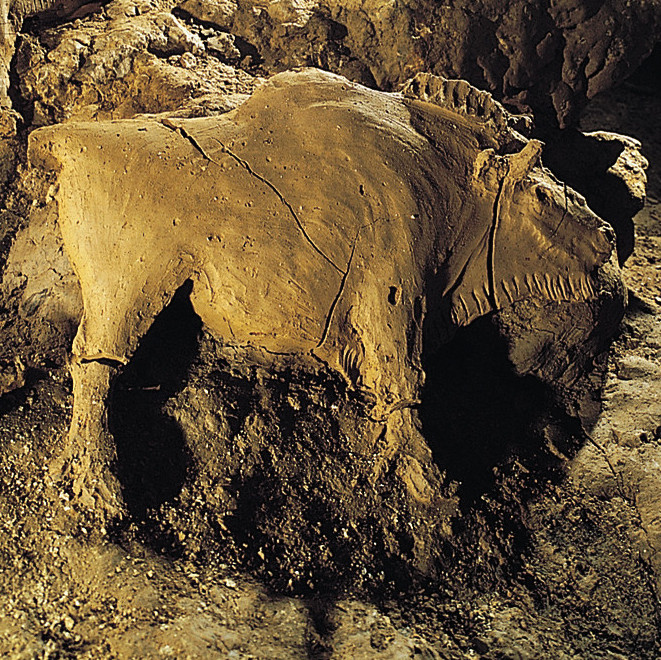Introduction
Buried deep within the rugged landscape of the Ariège region in southern France lies a remarkable treasure trove of prehistoric art. In the Le Tuc d’Audoubert cave, two exquisitely crafted bison sculptures have captivated the imagination of archaeologists and art enthusiasts alike. Estimated to be around 14,000 years old, these remarkable works of art from the Upper Paleolithic period showcase the incredible skill and artistic prowess of our ancestors.

Discovered in 1912 by the three teenage sons of the French count Henri Begouën, the bison sculptures have been remarkably well-preserved, thanks to the stable environment of the cave. Crafted in high relief from clay, these sculptures exhibit an astonishing level of detail and realism, providing a glimpse into the creative minds of the Magdalenian culture that flourished during the last Ice Age.
In this blog post, we will delve into the fascinating story behind these prehistoric masterpieces, exploring their historical context, the techniques used by the artists, and the significance of these remarkable sculptures in the broader scope of human artistic evolution.
The Discovery and Preservation of the Le Tuc d’Audoubert Bison
The story of the Le Tuc d’Audoubert bison sculptures begins in 1912, when three teenage boys – the sons of Count Henri Begouën – stumbled upon the entrance to the cave while exploring the rugged terrain of the Ariège region. The Begouën family had long been interested in the area’s rich archaeological heritage, and the boys were eager to uncover any hidden wonders that might lie within the cave system.
As the young explorers ventured deeper into the cave, they were met with a sight that would forever change the course of prehistoric art research. Nestled in a secluded chamber, they discovered two exquisitely crafted bison sculptures, meticulously sculpted from clay and standing in high relief against the cave walls.

The discovery of these remarkable sculptures was a watershed moment in the study of Paleolithic art. Prior to this find, the artistic achievements of our prehistoric ancestors had been primarily known through the stunning cave paintings found in sites like Lascaux and Chauvet. The Le Tuc d’Audoubert bison sculptures, however, represented a previously unknown artistic medium – the creation of three-dimensional clay sculptures.
What made the discovery even more remarkable was the exceptional state of preservation of the sculptures. Thanks to the stable and protected environment of the cave, the bison had remained largely untouched for over 14,000 years, allowing researchers to study them in incredible detail and gain unprecedented insights into the artistic practices of the Magdalenian culture.
The Magdalenian Culture and the Bison Sculptures
The Le Tuc d’Audoubert bison sculptures date back to the Upper Paleolithic period, specifically the Magdalenian culture, which flourished in Europe between 17,000 and 12,000 years ago. This was a time of significant cultural and artistic development, as our ancestors continued to hone their skills in hunting, tool-making, and the creation of elaborate works of art.
The Magdalenian culture is named after the site of La Madeleine in southwestern France, where some of the earliest examples of their distinctive artistic style were discovered. This culture is known for its exceptional cave paintings, intricate carvings, and the creation of a wide range of tools and artifacts, all of which showcase the ingenuity and creativity of Paleolithic humans.

The bison sculptures of Le Tuc d’Audoubert are a remarkable example of the Magdalenian artistic tradition. Crafted from clay, these sculptures were created using a technique known as “high relief,” where the figures are sculpted to protrude from the cave wall, creating a three-dimensional effect. This approach allowed the artists to capture the natural contours and musculature of the bison with incredible accuracy and detail.
The two bison sculptures, standing side by side, are believed to represent a male and a female. The male bison, with its imposing stature and prominent horns, is depicted in a more aggressive, defensive posture, while the female bison appears more relaxed and serene. This subtle difference in posture and expression suggests that the artists were not merely creating a generic representation of the species, but were imbuing their creations with a sense of individual character and personality.
The Artistic Techniques of the Magdalenian Sculptors
The Le Tuc d’Audoubert bison sculptures are a testament to the remarkable artistic skills and technical prowess of the Magdalenian sculptors. These prehistoric artists employed a range of techniques to shape the clay and bring their creations to life, showcasing an impressive level of artistic sophistication.
One of the most striking features of the sculptures is the level of detail and realism achieved by the artists. From the intricate textures that mimic the bison’s fur to the subtle musculature and anatomical features, the sculptures exhibit an astonishing attention to detail that is truly remarkable for their time.

To achieve this level of realism, the Magdalenian sculptors relied on a combination of their hands, fingernails, and simple tools to shape and manipulate the clay. By using their hands and fingers, they were able to create the soft, organic forms of the bison’s bodies, while the use of fingernails and tools allowed them to carve out the finer details, such as the contours of the muscles and the individual hairs of the fur.
The artists also demonstrated a keen understanding of the properties of clay and how to work with this malleable medium to create their masterpieces. They likely used a combination of techniques, such as coiling and pinching, to build up the sculptures layer by layer, gradually shaping and refining the forms until they achieved the desired level of realism and detail.
It’s important to note that the Magdalenian sculptors were not working in a vacuum; their artistic practices were likely influenced by the rich tradition of cave painting that was flourishing throughout the region at the time. The attention to detail and the use of naturalistic forms seen in the bison sculptures may have been informed by the techniques and styles developed by the cave painters, demonstrating the interconnectedness of the various artistic traditions during the Upper Paleolithic period.
The Significance of the Le Tuc d’Audoubert Bison Sculptures
The Le Tuc d’Audoubert bison sculptures hold immense significance in the broader context of human artistic evolution and the understanding of Paleolithic culture. These remarkable works of art provide us with a rare and invaluable glimpse into the creative minds of our ancestors, offering insights into their worldview, their relationship with the natural world, and their artistic sensibilities.
One of the most significant aspects of the bison sculptures is their level of realism and attention to detail. The artists’ ability to capture the nuances of the bison’s anatomy, from the texture of the fur to the musculature of the body, suggests a deep understanding of the natural world and a keen observational eye. This level of realism is particularly remarkable given the limited tools and resources available to Paleolithic artists, and it speaks to the creative ingenuity and technical skill of the Magdalenian sculptors.
Moreover, the sculptures’ placement within the cave system, in a secluded and protected chamber, suggests that they may have held a ritualistic or symbolic significance for the Magdalenian people. The careful positioning of the two bison, with one in a more aggressive pose and the other more serene, could indicate that the sculptures were imbued with deeper meaning, perhaps representing the delicate balance between the natural world and the spiritual realm.
The discovery of the Le Tuc d’Audoubert bison sculptures has also had a profound impact on our understanding of Paleolithic art and the creative capacities of our prehistoric ancestors. Prior to this find, the artistic achievements of the Magdalenian culture were primarily known through the stunning cave paintings found in sites like Lascaux and Chauvet. The discovery of these three-dimensional clay sculptures has expanded our understanding of the diverse artistic mediums employed by Paleolithic artists, and has challenged the notion that their artistic expression was limited to two-dimensional works.
Furthermore, the exceptional state of preservation of the Le Tuc d’Audoubert bison sculptures has provided researchers with an invaluable opportunity to study the techniques and materials used by Paleolithic artists, offering new insights into the creative processes and artistic traditions of our ancestors. This knowledge has, in turn, enriched our understanding of the cultural and cognitive development of early human societies, and has sparked ongoing discussions about the origins and evolution of artistic expression.
Conclusion
The bison sculptures of Le Tuc d’Audoubert stand as a testament to the extraordinary artistic abilities and creative ingenuity of our Paleolithic ancestors. Crafted with meticulous attention to detail and imbued with a remarkable sense of realism, these remarkable works of art offer a rare and invaluable glimpse into the artistic and cultural traditions of the Magdalenian people.
The discovery of these sculptures in 1912 was a watershed moment in the study of Paleolithic art, expanding our understanding of the diverse range of artistic mediums employed by our prehistoric forebears. The exceptional state of preservation of the sculptures, coupled with the wealth of information they provide about the creative processes and techniques used by Magdalenian artists, has made them an invaluable resource for researchers and art enthusiasts alike.
As we continue to explore and unravel the mysteries of the past, the bison sculptures of Le Tuc d’Audoubert serve as a powerful reminder of the enduring creative spirit of humanity. They inspire us to look beyond the limitations of our own time and place, and to appreciate the remarkable artistic achievements of those who came before us – a testament to the timeless power of human creativity and the enduring legacy of our ancestors.

